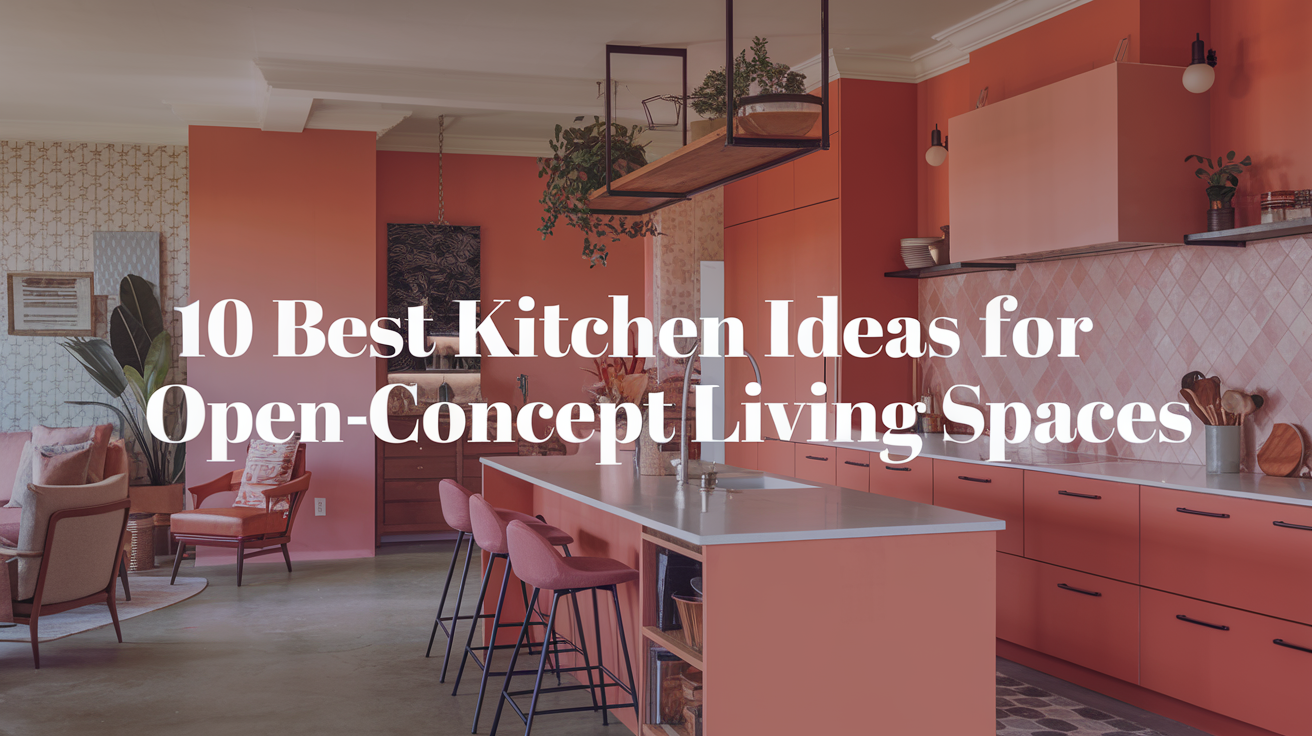This post contains affiliate links, which means I may receive a commission from qualifying purchases made through these links. As an Amazon Associate, I earn from qualifying purchases and will only recommend products I have personally used! Learn more on my Affiliate Disclosure Page and Privacy Policy Page.
Open-concept living spaces are the heart of modern homes—where cooking, entertaining, and daily life blend seamlessly. But designing a kitchen that flows effortlessly into your living or dining area can feel daunting. How do you create cohesion without sacrificing style? How do you keep clutter at bay when everything’s on display? Don’t worry! I’ve curated 10 kitchen ideas that’ll transform your open-concept space into a functional, inviting haven. Let’s get inspired!
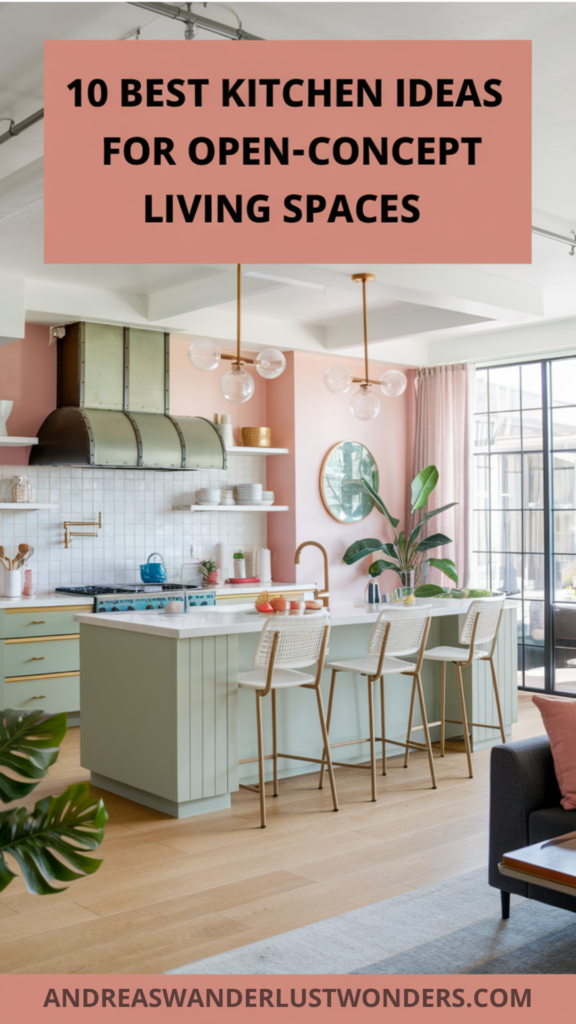
1. The Multi-Tasking Kitchen Island
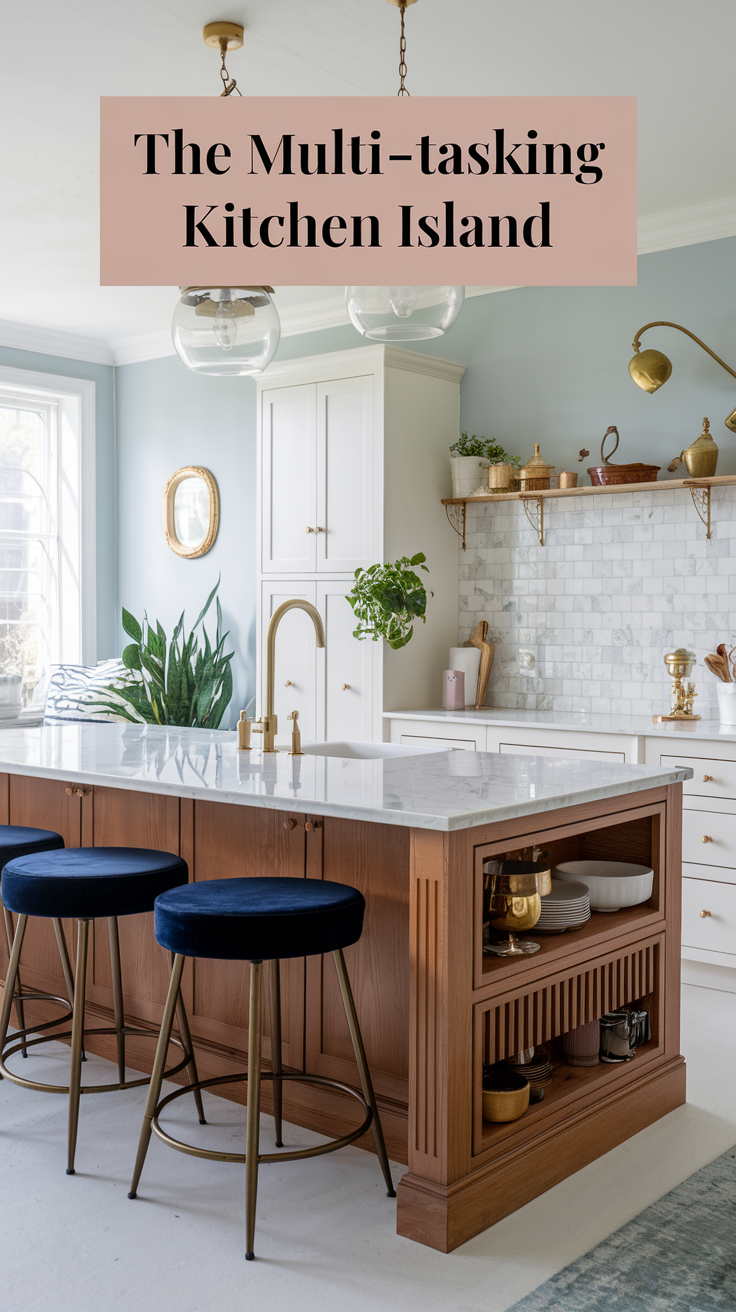
How-To: Design an island that serves as a prep station, dining spot, and storage hub. Opt for a mix of open shelving, drawers, and seating.
What You Might Need:
- Quartz or butcher block countertop
- Adjustable bar stools
- Under-island outlets or USB ports
- Pull-out trash/recycling bins
Picture This: A waterfall-edge island in warm walnut, topped with a marble slab. On one side, family members sip smoothies on navy velvet stools; on the other, you chop veggies while chatting with guests.
Pro Tip: Leave 36–42 inches of walkway around the island for smooth traffic flow.
SEO Keywords: kitchen island ideas, open-concept kitchen layout, multifunctional kitchen island
2. Unified Color Palette for Visual Harmony
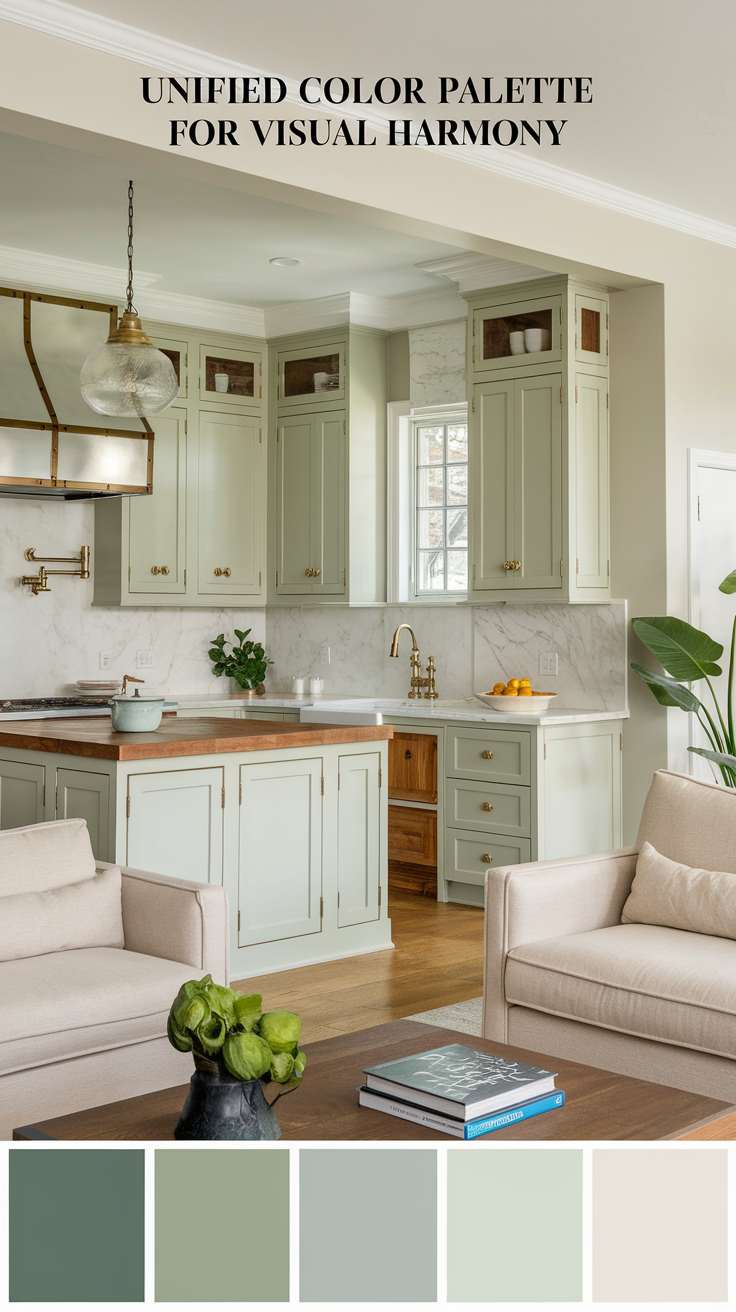
How-To: Choose 3–4 core colors that repeat in your kitchen and living area (e.g., cabinetry, throw pillows, rugs).
What You Might Need:
- Paint swatches or a digital mood board
- Coordinating decor (vases, towels, art)
Picture This: Soft sage-green cabinets that mirror the living room’s botanical wallpaper, with brass hardware echoing the coffee table legs.
Pro Tip: Use a neutral base (white, gray) to let accent colors shine.
SEO Keywords: cohesive kitchen design, color scheme for open spaces
3. Zone-Defining Lighting
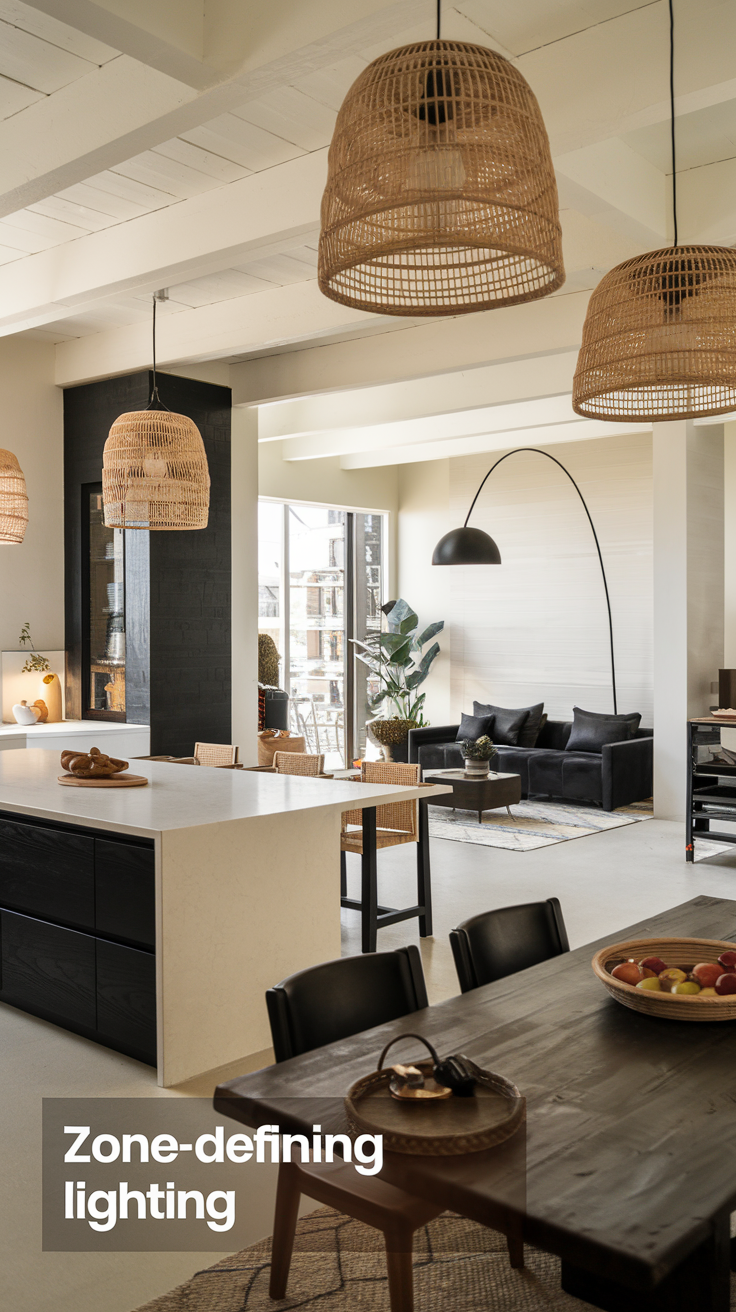
How-To: Layer pendant lights over the island, recessed lighting for tasks, and floor lamps in the lounge area.
What You Might Need:
- Dimmable LED pendant lights
- Plug-in under-cabinet lighting
- Smart bulbs for adjustable warmth
Picture This: A trio of woven rattan pendants casting a warm glow over the island, while a sleek arc lamp illuminates the sofa for evening reading.
Pro Tip: Match finish colors (e.g., black, brass) across fixtures for continuity.
SEO Keywords: kitchen lighting ideas, open-concept lighting design
4. Strategic Rug Placement
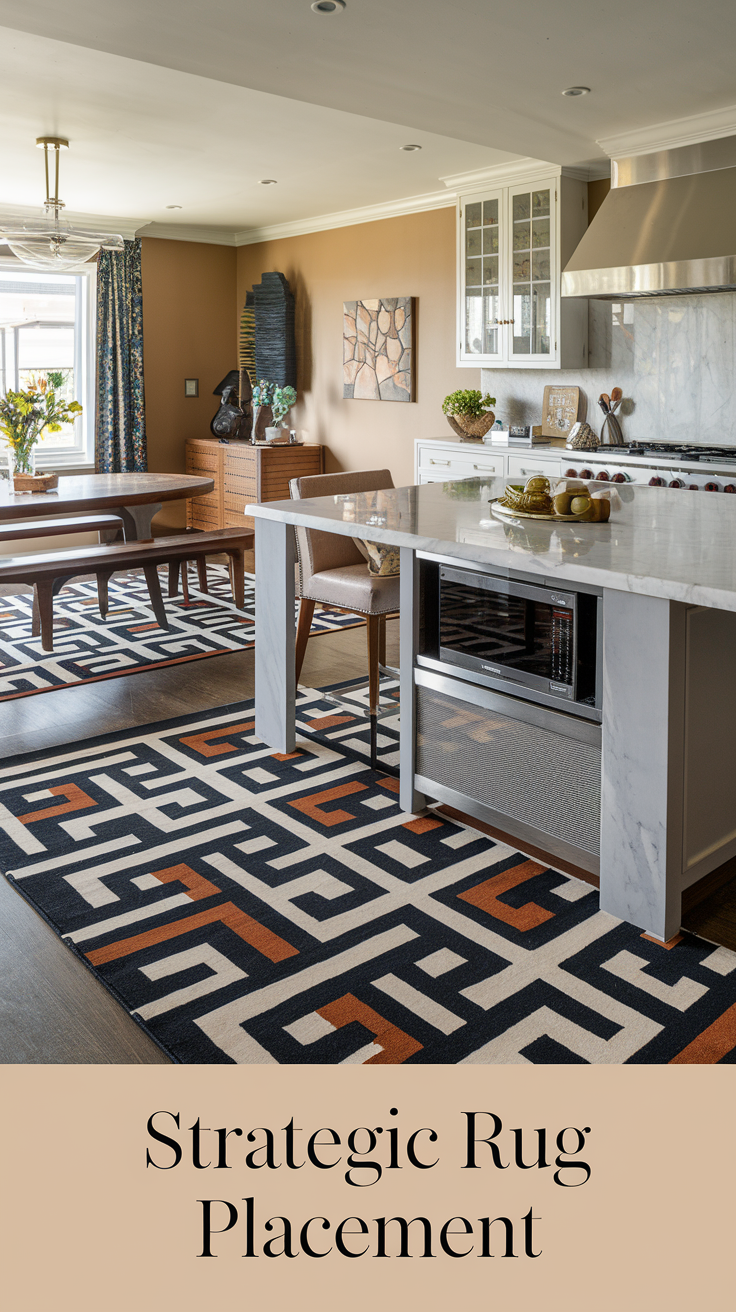
How-To: Use durable, low-pile rugs to define the kitchen “zone” and reduce noise.
What You Might Need:
- Washable indoor/outdoor rugs
- Rug grippers or pads
Picture This: A bold geometric rug under the island, tying into the living room’s navy-and-mustard accent chairs.
Pro Tip: Avoid shag rugs—they trap crumbs!
SEO Keywords: kitchen rug ideas, open floor plan decor
5. Hidden Storage Solutions
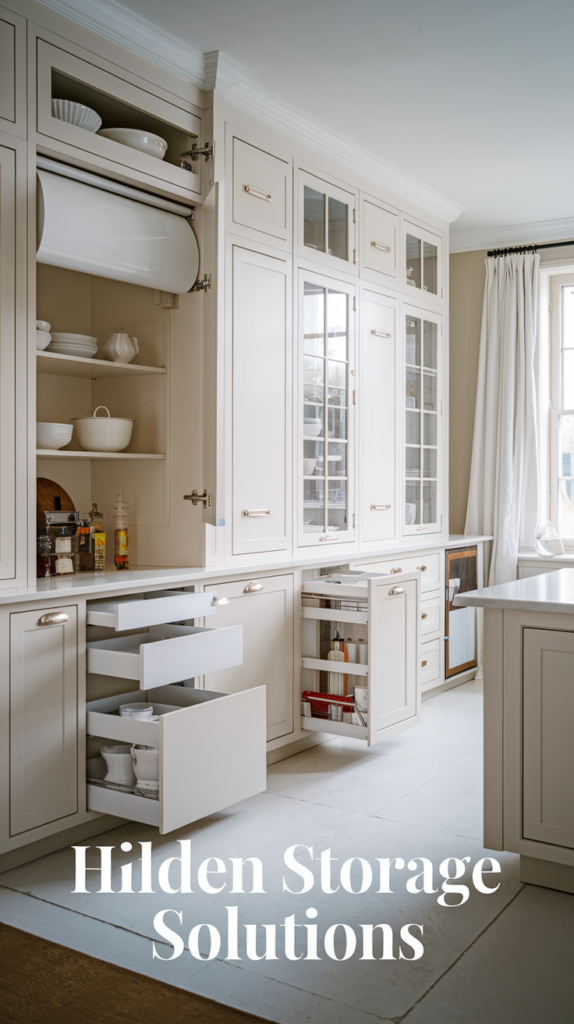
How-To: Maximize vertical space with floor-to-ceiling cabinets, pull-out pantries, and toe-kick drawers.
What You Might Need:
- Custom cabinetry or IKEA hacks
- Soft-close hinges
- Drawer organizers
Picture This: A sleek wall of white cabinets hiding small appliances, with a hidden coffee station that slides out during breakfast chaos.
Pro Tip: Use labeled bins for snacks, making them easy to grab during movie nights.
SEO Keywords: kitchen storage ideas, clutter-free open kitchen
6. Cohesive Flooring Throughout
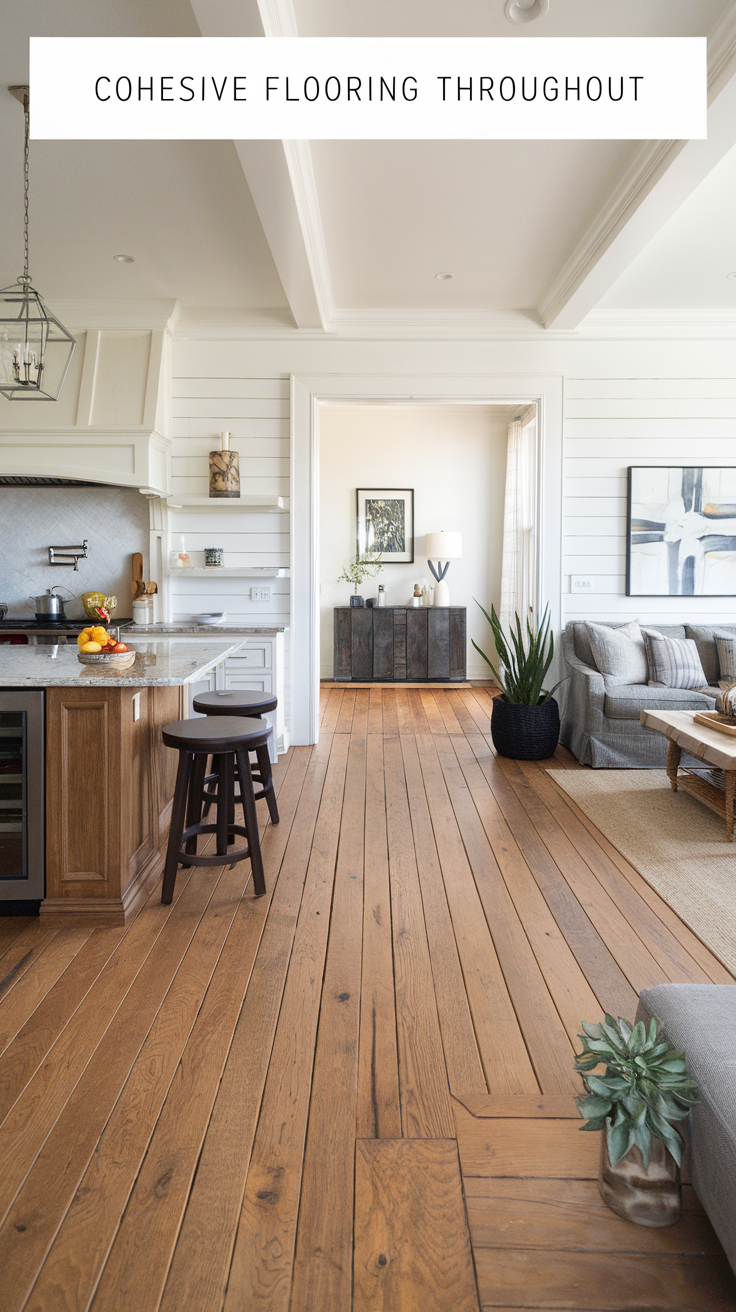
How-To: Extend the same flooring material (hardwood, tile) from the kitchen into the living area.
What You Might Need:
- Durable hardwood or luxury vinyl planks
- Area rugs to soften high-traffic zones
Picture This: Wide-plank oak floors flowing uninterrupted from the kitchen island to the living room’s cozy reading nook.
Pro Tip: Choose scratch-resistant finishes if you have pets.
SEO Keywords: open-concept flooring, seamless kitchen design
7. Statement Backsplash as Art
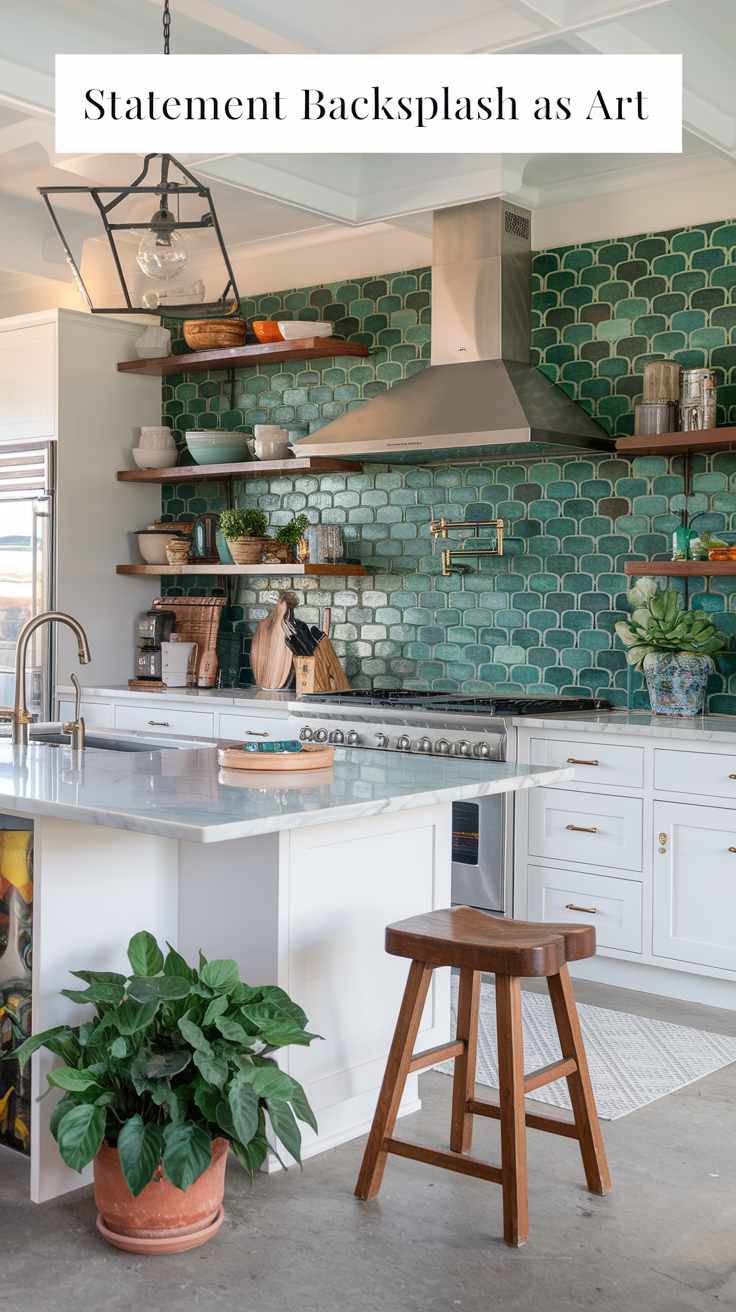
How-To: Use bold tiles (geometric, hand-painted) to create a focal point visible from the living area.
What You Might Need:
- Peel-and-stick tiles for renters
- Grout and tile spacers
Picture This: An emerald green Moroccan tile backsplash that pops against white cabinets, drawing the eye from the sofa to the kitchen.
Pro Tip: Continue the backsplash material to the dining area’s accent wall.
SEO Keywords: kitchen backsplash ideas, open-concept focal points
8. Foldable or Mobile Furniture
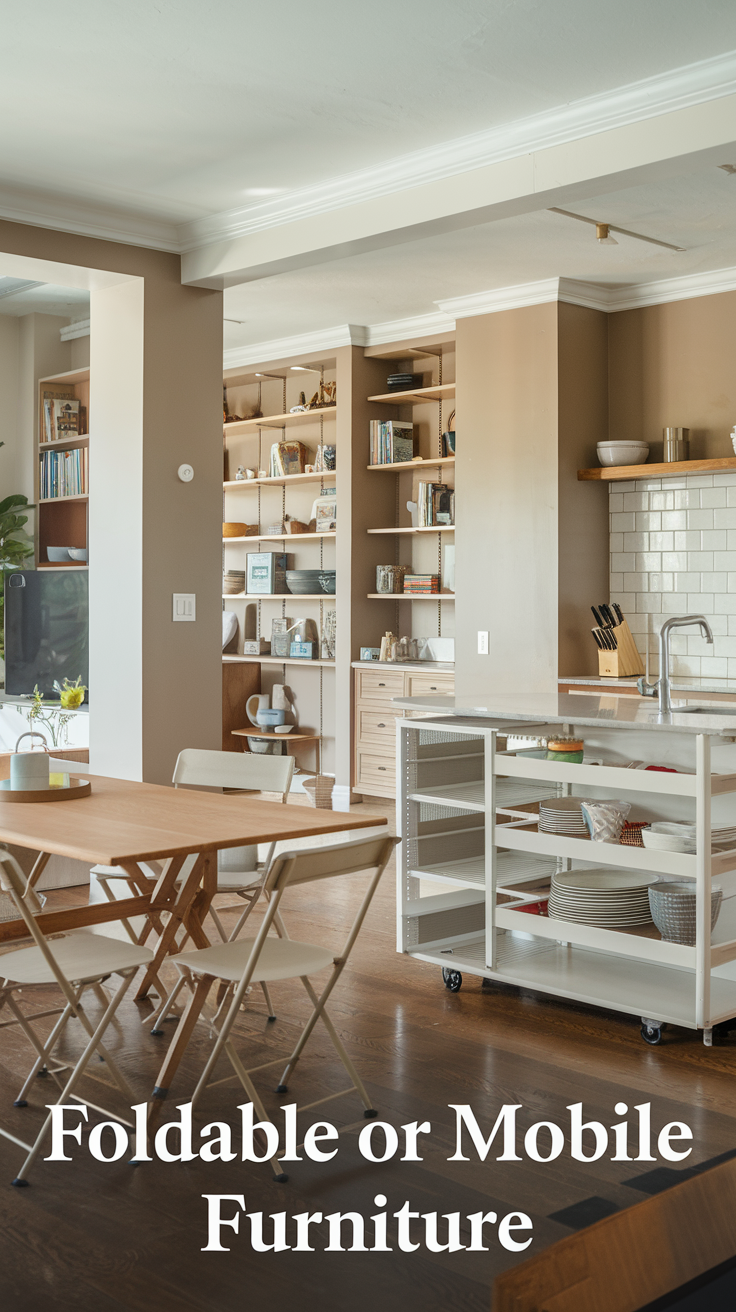
How-To: Incorporate nesting tables, fold-down desks, or a kitchen cart for flexible use.
What You Might Need:
- Rolling kitchen island
- Wall-mounted drop-leaf table
Picture This: A vintage baker’s rack on wheels that holds spices during dinner prep, then rolls aside to expand the living room for game night.
Pro Tip: Use furniture with locking wheels for stability.
SEO Keywords: small open kitchen ideas, flexible kitchen furniture
9. Greenery to Soften Transitions
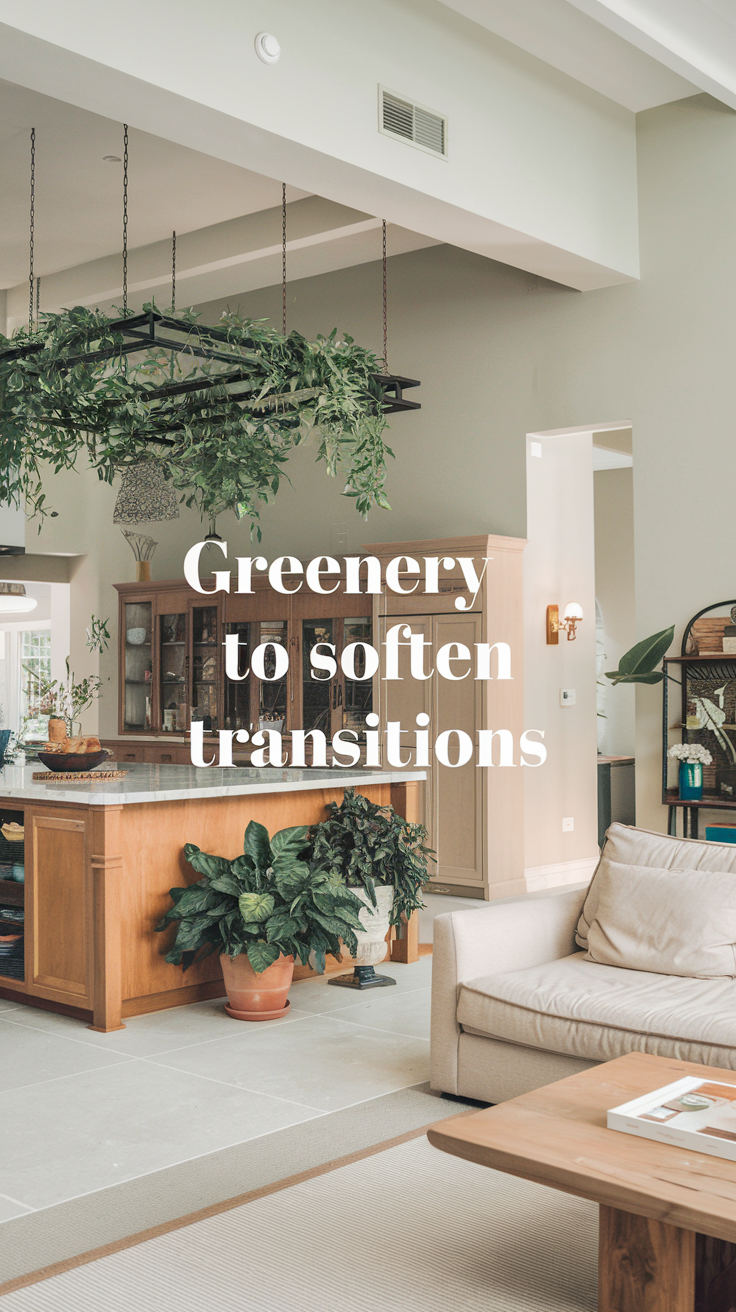
How-To: Place herbs, hanging plants, or a tall fiddle-leaf fig between the kitchen and living zones.
What You Might Need:
- Hanging macramé planters
- Self-watering pots
Picture This: A trailing pothos spilling from a shelf above the sink, mirrored by a potted olive tree next to the TV stand.
Pro Tip: Use plant stands at varying heights for visual interest.
SEO Keywords: kitchen plants, open-concept greenery
10. Smart Tech for Invisible Functionality
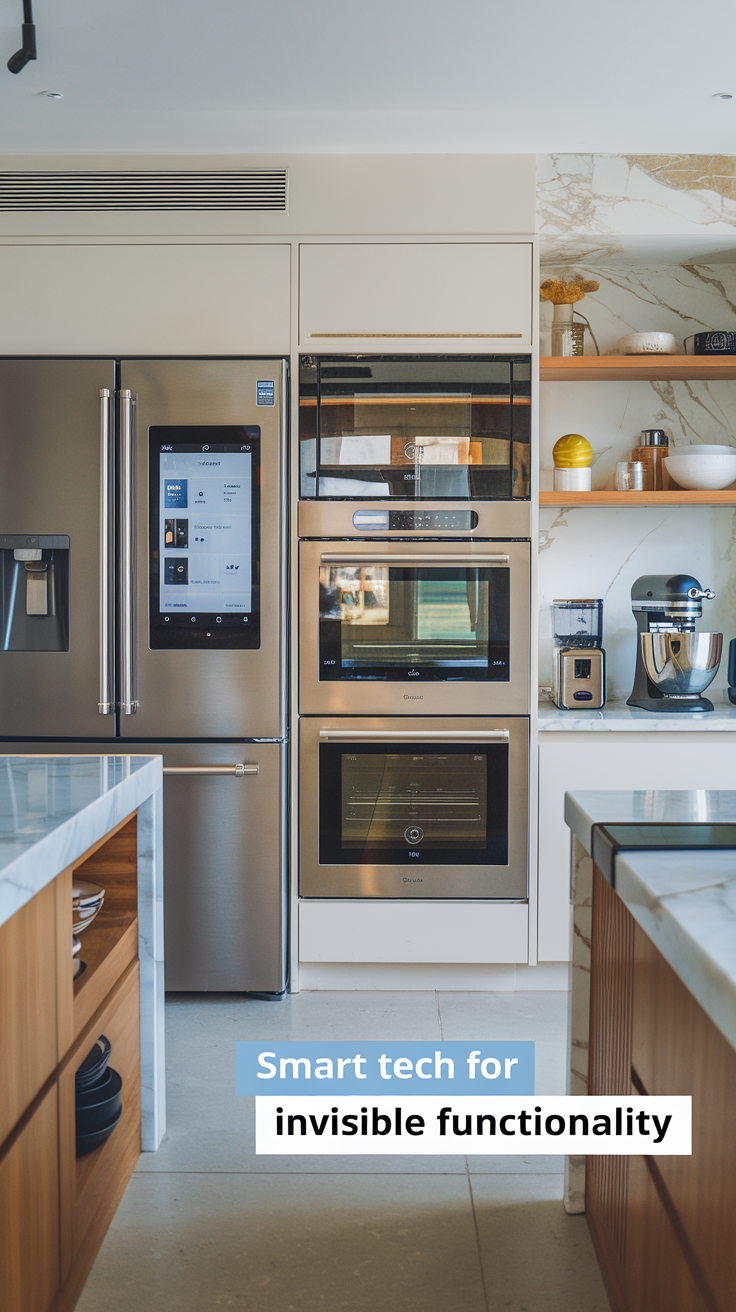
How-To: Integrate voice-controlled lights, hidden charging stations, or a Wi-Fi-enabled oven.
What You Might Need:
- Smart speaker (Alexa, Google Nest)
- Under-cabinet wireless chargers
Picture This: “Hey Google, turn on dinner party mode!” The lights dim, the oven preheats, and your playlist starts—all while you pour wine for friends.
Pro Tip: Hide tech cords in decorative boxes or cable organizers.
SEO Keywords: smart kitchen ideas, tech-savvy open kitchen
Key Takeaways
- Prioritize Flow: Ensure clear pathways (36–42 inches wide) between zones.
- Cohesion is Key: Repeat colors, materials, and finishes in the kitchen and living areas.
- Hide Clutter: Invest in smart storage to keep counters clean and sight lines open.
- Lighting Layers: Combine task, ambient, and accent lighting for functionality and mood.
- Flexibility Wins: Use movable furniture and tech to adapt your space for any occasion.
Final Thoughts
Designing an open-concept kitchen isn’t about perfection—it’s about creating a space that works for your life. Whether you’re whipping up pancakes while helping with homework or hosting a wine-and-cheese night, your kitchen should feel connected, not chaotic. Start small: maybe a fresh coat of paint or a statement rug. Then, build on what makes you smile.
Remember, the best open-concept spaces evolve with you. So embrace the mess, celebrate the connection, and let your kitchen tell your story. Ready to take the leap? Tag me or leave a comment with your kitchen journey—I’d love to cheer you on!
FAQs: Your Open-Concept Concerns Solved
Q: Will an open kitchen make my home look cluttered?
A: Not if you prioritize hidden storage and limit countertop decor. Use closed cabinets and stylish bins!
Q: How do I reduce cooking smells in an open layout?
A: Install a high-quality range hood, simmer citrus peels, or use an air purifier with a charcoal filter.
Q: Can I mix modern and rustic styles?
A: Absolutely! Pair shaker cabinets (rustic) with sleek appliances (modern) and a reclaimed wood dining table.
Q: What flooring is best for open spaces?
A: Durable, scratch-resistant options like hardwood, luxury vinyl, or porcelain tile.
Q: How do I define zones without walls?
A: Use rugs, lighting, and furniture arrangements (e.g., a sofa facing away from the kitchen).
Q: Are open kitchens noisy?
A: Soften sound with rugs, curtains, and upholstered furniture. Avoid echoing hard surfaces.
